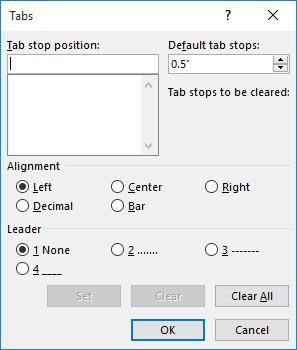Please Note: This article is written for users of the following Microsoft Word versions: 2007, 2010, 2013, 2016, 2019, 2021, and Word in Microsoft 365. If you are using an earlier version (Word 2003 or earlier), this tip may not work for you. For a version of this tip written specifically for earlier versions of Word, click here: Setting Decimal Tabs in a Table Using the Keyboard.
Written by Allen Wyatt (last updated May 18, 2024)
This tip applies to Word 2007, 2010, 2013, 2016, 2019, 2021, and Word in Microsoft 365
If you love using the keyboard, you may wonder if there is a way to set decimal tabs in a table using the keyboard. Unfortunately, there is no simple, fast keystroke to set the decimal tabs. The best way is to use the regular accelerator keys that Word uses. You would follow these steps:

Figure 1. The Tabs dialog box.
If you would rather not go through such an easy-to-remember process (grin), then you can also create a macro that will do the trick, and assign the macro to a shortcut key. The following is an example of a simple VBA macro that would do the job:
Sub SetDecimal()
Dim MyTab As String
MyTab = InputBox("Location (inches):", "Set Decimal Tab")
If Val(MyTab) > 0 Then
With Selection.ParagraphFormat.TabStops
.ClearAll
.Add Position:=InchesToPoints(Val(MyTab)), _
Alignment:=wdAlignTabDecimal, _
Leader:=wdTabLeaderSpaces
End With
End If
End Sub
This macro, which should be run after the cell or column is selected, prompts the user to enter a value for the new tab stop, clears all the existing tabs in the selection, and then sets the desired decimal tab stop.
Note:
WordTips is your source for cost-effective Microsoft Word training. (Microsoft Word is the most popular word processing software in the world.) This tip (11758) applies to Microsoft Word 2007, 2010, 2013, 2016, 2019, 2021, and Word in Microsoft 365. You can find a version of this tip for the older menu interface of Word here: Setting Decimal Tabs in a Table Using the Keyboard.

Learning Made Easy! Quickly teach yourself how to format, publish, and share your content using Word 2021 or Microsoft 365. With Step by Step, you set the pace, building and practicing the skills you need, just when you need them! Check out Microsoft Word Step by Step today!
If you get a document that has all sorts of wonky tab stops defined, it is an easy task to get rid of them all and set ...
Discover MoreTabs don't normally show up in your printed document, but Word allows you to still search for them. All you need to do is ...
Discover MoreNeed to get rid of all the tab stops in a particular document? It's easy to do when you apply the technique outlined in ...
Discover MoreFREE SERVICE: Get tips like this every week in WordTips, a free productivity newsletter. Enter your address and click "Subscribe."
There are currently no comments for this tip. (Be the first to leave your comment—just use the simple form above!)
Got a version of Word that uses the ribbon interface (Word 2007 or later)? This site is for you! If you use an earlier version of Word, visit our WordTips site focusing on the menu interface.
Visit the WordTips channel on YouTube
FREE SERVICE: Get tips like this every week in WordTips, a free productivity newsletter. Enter your address and click "Subscribe."
Copyright © 2026 Sharon Parq Associates, Inc.
Comments